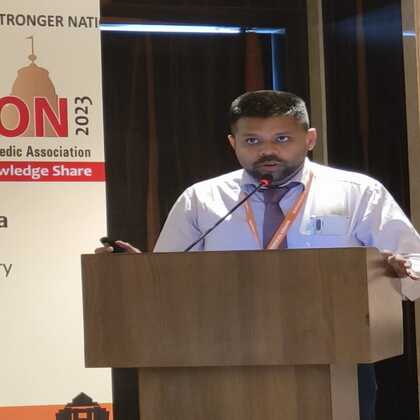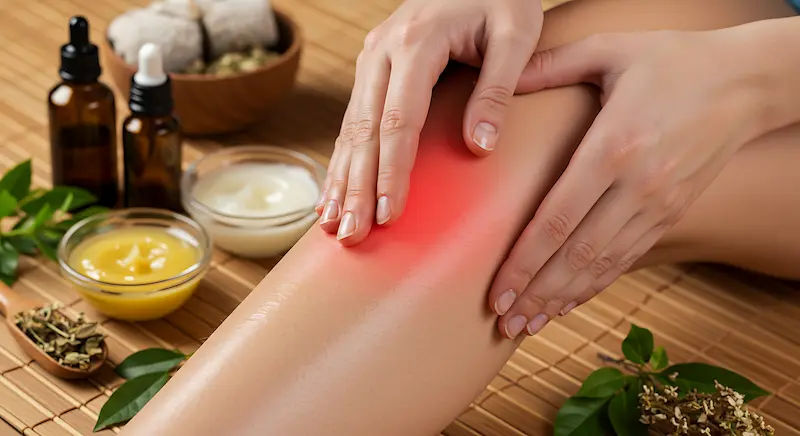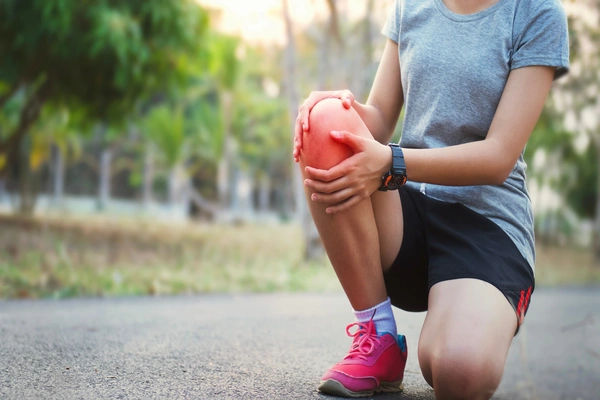Natural Treatments for Knee Pain: Safe and Effective Relief
Discover natural treatments for knee pain that reduce discomfort and improve function. Learn exercises, weight management tips, topical remedies, herbal supplements, braces, mind–body strategies, and diet changes to support knee health.

Written by Dr. J T Hema Pratima
Reviewed by Dr. Rohinipriyanka Pondugula MBBS
Last updated on 24th Oct, 2025

Introduction
Knee pain can slow down everything—from your morning walk to simply getting up from a chair. Whether your discomfort stems from osteoarthritis, a previous injury, overuse, or stiffness from inactivity, the good news is that many natural treatments can help reduce pain and improve function. In this guide, we’ll walk through safe, research-backed strategies you can try at home, including gentle exercises, heat and cold therapy, weight management, topical remedies, herbal options, braces and supports, mind–body techniques, and diet changes. We’ll also cover when to see a doctor, how to prevent flare-ups, and how to combine natural care with medical options when needed. If symptoms persist beyond two weeks or affect your daily activities, consult a doctor online with Apollo 24|7 for further evaluation and personalised advice. Let’s explore the most effective natural treatments for knee pain—so you can move with more comfort and confidence.
Understanding Knee Pain: Common Causes and Patterns
Knee pain is usually driven by one of three categories: osteoarthritis (wear-and-tear with low-grade inflammation), overuse (tendons and soft tissues irritated by repetitive load), or acute injury (ligament strains, meniscus tears, fractures). Osteoarthritis often causes morning stiffness that eases with gentle movement, while overuse pain tends to flare with activity and settle with rest. Mechanical pain feels worse when loading the joint (stairs, squats), whereas inflammatory pain may ache at rest or at night with noticeable swelling.
Recognising patterns helps you choose the right home strategy. For instance, a puffy, warm knee after an activity spike may benefit from ice and compression the first 24–48 hours, followed by gentle mobility and low-impact cardio. Front-of-knee pain with prolonged sitting or stairs may indicate patellofemoral pain, where quadriceps and hip strengthening prove useful.
Urgent care is needed for severe trauma, inability to bear weight, obvious deformity, fever with a hot swollen joint, or sudden swelling without injury. If symptoms persist beyond two weeks or disrupt daily life, consult a doctor online with Apollo 24|7 for assessment and a personalised plan.Consult Top Specialists Here
Quick Relief at Home: Heat, Cold, and Compression
Ice vs heat depends on timing and symptoms. Ice helps reduce acute inflammation and swelling in the first 24–48 hours after a flare or minor strain. Apply a wrapped ice pack for 10–15 minutes, 3–5 times per day. Heat works better for stiffness and muscle tension—apply a warm pack or take a warm shower for 10–20 minutes before gentle movement.
Compression sleeves or elastic bandages can reduce swelling and provide proprioceptive support. Elevation (ankle above heart level) also aids fluid return, especially after long days on your feet. Together, RICE (rest, ice, compression, elevation) is a safe first-line approach for short-term relief. As pain eases, gradually reintroduce movement to avoid joint stiffness.
48-hour RICE protocol:
• Day 1: Ice 10–15 minutes every 3–4 hours; light compression; elevation whenever seated.
• Day 2: Transition to 2–3 icing sessions; add gentle range-of-motion (heel slides, knee extensions); start short walks on flat surfaces.
• Day 3+: Swap to heat as needed for stiffness; begin low-impact cardio.
Try “contrast therapy” after the first 48 hours—alternate 2 minutes of warm and 1 minute of cool compress, 3–5 rounds, to stimulate circulation in subacute phases.
The Exercise Prescription: Strength, Flexibility, and Balance
Movement is medicine for knee pain. Low-impact cardio improves joint lubrication and endurance without excess load. Options include brisk walking (if tolerated), cycling (recumbent bikes are knee-friendly), swimming, or deep-water jogging. Aim for 20–30 minutes, 3–5 days per week, starting at a conversational pace.
Strengthening is crucial. Weak quadriceps and hips increase stress on the knee joint. Evidence supports targeted exercises for knee osteoarthritis and patellofemoral pain, often improving pain in 6–12 weeks. Start with:
• Quad sets and straight-leg raises (3 sets of 10–12 reps)
• Mini-squats to a chair and step-ups on a low step
• Glute bridges and side-lying leg lifts for hip support
• Calf raises for ankle stability
Mobility and flexibility reduce tension on the joint. Try hamstring and calf stretches (20–30 seconds, 3–4 times each), twice daily initially. Gentle yoga poses (e.g., supported warrior, chair pose to tolerable depth) can build balanced strength.
15-minute routine:
• Warm up 3 minutes (marching, gentle cycling)
• Strength circuit 10 minutes (2 rounds): chair squats x10, step-ups x10/leg, bridges x12, side-lying leg lifts x12/leg, calf raises x12
• Cool down 2 minutes stretching
Use “pain-monitoring” during exercise: keep pain ≤3/10 during and after; slight increase that settles within 24 hours is acceptable.Consult Top Specialists Here
Weight Management: Small Changes, Big Pain Reduction
Every kilogram of body weight adds roughly 3–4 kilograms of pressure across the knee during walking. Even modest weight loss (5–10% of body weight) can significantly reduce knee osteoarthritis pain and improve function over months. Practical strategies:
• Swap sugary beverages for water or unsweetened tea.
• Fill half your plate with vegetables; prioritise lean protein and fibre-rich carbs.
• Incorporate “movement snacks” like 5-minute walks after meals to aid glucose control, which can also benefit joint tissues.
Set realistic goals: 0.25–0.5 kg per week. Pair nutrition with low-impact cardio for sustainable results. Apollo 24|7 offers convenient home collection for tests like vitamin D or HbA1c to guide your plan.
Track “non-scale victories” (stairs feel easier, less morning stiffness) to stay motivated even when the scale moves slowly.
Topical Relief: Creams, Gels, and Patches
Topical NSAID gels (e.g., diclofenac) can reduce knee osteoarthritis pain with fewer systemic side effects than oral NSAIDs. Evidence suggests meaningful relief within 1–2 weeks when applied 2–4 times daily as directed. Capsaicin cream, derived from chili peppers, may reduce pain by depleting substance P in nerves; it often requires consistent use for 2–4 weeks to notice benefit. Menthol-based rubs and methyl salicylate provide short-term cooling/warming sensations that can ease muscle tension.
How to use safely:
• Apply to clean, dry skin; wash hands after.
• Avoid broken skin or combining multiple topicals on the same area to reduce irritation.
• Test a small patch first if you have sensitive skin.
Use topicals 20–30 minutes before exercise or physical therapy to make movement more comfortable, enabling better form and adherence.
Herbal and Natural Supplements: What’s Worth Considering
Some natural supplements have emerging evidence for knee pain:
• Turmeric/curcumin: Anti-inflammatory; standardized extracts (e.g., 500–1000 mg curcuminoids/day) may help osteoarthritis pain when taken with piperine for absorption. Start low to minimise GI upset.
• Boswellia serrata: May reduce inflammatory enzymes; typical doses 100–250 mg of AKBA-standardized extracts twice daily.
• Ginger: Anti-inflammatory and analgesic; often used as tea or capsules (e.g., 1–2 g/day).
• Omega-3 fatty acids: Support systemic anti-inflammatory pathways; 1–2 g EPA/DHA daily from fish oil or algae sources.
Glucosamine and chondroitin show mixed results; some people with knee osteoarthritis report benefit after 2–3 months, especially with sulfate forms.
Safety reminders:
• Interactions are possible (e.g., curcumin with blood thinners).
• Discuss with a clinician, particularly if you take anticoagulants, diabetes medications, or have gallbladder issues.
• Choose third-party tested brands for quality.
Trial supplements one at a time for 8–12 weeks while tracking pain and function; this helps you identify what truly works for you.
Bracing, Taping, and Footwear: External Support That Helps
Bracing can offload painful compartments in osteoarthritis or stabilise the patella in front-of-knee pain. Unloader braces may reduce medial compartment load; soft compression sleeves can improve comfort and confidence for daily movement. For patellofemoral pain, a brace with a patellar cutout or lateral buttress may help alignment.
Kinesiology taping can cue better tracking and reduce discomfort during activity; try a simple Y-strip around the kneecap as taught by a physical therapist. Footwear matters more than most realise: supportive shoes with adequate cushioning and, if needed, off-the-shelf insoles can improve knee mechanics, especially if you overpronate.
Rotate shoes rather than wearing the same pair daily; varied footwear can subtly change loading patterns and reduce repetitive stress.
Mind–Body Strategies and Sleep: Calming the Pain System
Chronic pain is influenced by both tissues and the nervous system. Simple daily practices can reduce pain amplification:
• 4-7-8 breathing for 3–5 minutes to activate the parasympathetic response.
• Brief body scan meditations or guided imagery to reduce muscle guarding.
• Pacing: alternate tasks and rest before pain spikes, rather than pushing until flare-ups.
Sleep is a pain modulator. Aim for 7–9 hours:
• Consistent sleep/wake times
• Dark, cool bedroom
• Limit caffeine after midday; dim screens 1 hour before bed
• A short wind-down routine (stretching, warm shower)
Pair breathwork with gentle knee mobility before sleep; many people find morning stiffness easier when the nervous system is calmer overnight.
Anti-Inflammatory Eating for Knee Health
A Mediterranean-style diet—rich in vegetables, fruits, legumes, whole grains, nuts, olive oil, and fish—supports lower systemic inflammation. Key foods:
• Fatty fish (salmon, sardines) for omega-3s
• Berries and leafy greens for polyphenols
• Extra-virgin olive oil for monounsaturated fats
• Spices like turmeric and ginger
Hydration supports cartilage health and recovery; aim for enough water to keep urine pale. Micronutrients like vitamin D and magnesium are important for bone and muscle function. If you suspect deficiency, Apollo 24|7 offers convenient home collection for tests like vitamin D.
Simple weekly idea: Two fish dinners, daily leafy greens, beans 3x/week, snack on nuts and fruit, cook with olive oil, sprinkle turmeric and pepper into soups and eggs.
Try a “bright plate” rule—include at least three colours at each meal to naturally diversify anti-inflammatory compounds.
Everyday Habits: How You Sit, Stand, and Move Matters
Small tweaks reduce strain:
• Alternate sitting and standing; avoid deep sitting angles for long periods.
• Use a footrest when seated if your chair is low; it reduces knee flexion tension.
• On stairs, lead with the stronger leg going up, and the more comfortable leg first going down.
• Break up repetitive tasks with brief mobility breaks.
Activity modification doesn’t mean stopping what you love. Runners can shorten stride and increase cadence; hikers can use trekking poles; gardeners can use kneeling pads and hip-hinge techniques.
Adopt a “1% rule”—aim for a 1% improvement in comfort or capacity each week (one extra rep, one additional minute of walking). Over 3 months, that compounds.
Natural Treatments for Different Knee Conditions
Osteoarthritis (OA): Focus on low-impact cardio, quad/hip strengthening, weight management, and topical NSAIDs or capsaicin. Heat for stiffness, ice for swelling. Consider turmeric or fish oil. Unloader braces may help if one compartment is worse.
Patellofemoral pain: Emphasise hip abductors/extensors and quadriceps endurance, taping or patellar braces, and footwear that improves alignment. Avoid deep knee flexion initially; progress with pain-monitoring.
Tendinopathies/bursitis: Relative rest, progressive loading (eccentric or isometric exercises), and careful return to sport. Ice after provocative activities; consider cross-training and technique tweaks.
Isometrics (e.g., wall sits at tolerable angles for 30–45 seconds) can reduce tendon pain in the short term and prepare you for concentric/eccentric work.
Combining Natural Remedies with Medical Care
Most people do best with a blended approach. Add physical therapy if pain limits progress after 2–4 weeks of home care or if you need individualised form coaching and progression. Imaging (X-ray, MRI) isn’t always necessary for non-traumatic pain but may be considered if pain is severe, persistent, or accompanied by mechanical symptoms (locking, giving way). Injections (corticosteroids, hyaluronic acid) are options for selected cases; discuss risks and benefits with a clinician.
If your condition does not improve after trying these methods, book a physical visit to a doctor with Apollo 24|7. For metabolic or inflammatory contributors, Apollo 24|7 offers home collection for labs like vitamin D, HbA1c, CRP, or uric acid when indicated.
Bring your exercise log and response to topicals or supplements to your appointment—this data helps tailor more precise care.
Realistic Timelines, Tracking Progress, and Staying Motivated
• 2 weeks: Expect small improvements in stiffness, confidence with movement, better sleep, and reduced swelling with RICE and topicals.
• 6 weeks: Noticeable strength gains; daily tasks like stairs and standing feel easier. Cardio sessions feel smoother.
• 12 weeks: Meaningful functional improvements; many can increase walking distance or return to lighter recreational activities.
Track three metrics weekly: pain (0–10), function (e.g., how many stairs, sit-to-stands in 30 seconds), and mood/sleep. Celebrate plateaus as consolidation phases, not failures.
Use a “two-path” plan—if pain is ≤3/10, do the full session; if >3/10, switch to your “flare plan” (shorter, gentler routine) to maintain momentum without overloading.
Safety First: What to Avoid and When to Stop
Avoid:
• Rapid jumps in activity volume or deep flexion-heavy workouts in early rehab
• Stacking multiple new supplements at once
• Heat on acutely swollen knees in the first 24–48 hours
Stop and seek care if:
• Pain escalates week to week despite modifications
• Night pain wakes you consistently
• The knee gives way or locks
• Fever or redness accompanies swelling
If symptoms persist beyond two weeks, consult a doctor online with Apollo 24|7 for further evaluation.
Putting It All Together: A 4-Week Natural Knee Relief Plan
• Week 1: RICE as needed; 15-minute daily routine; 2 sessions of low-impact cardio (10–15 minutes); start topical gel; tidy up sleep habits.
• Week 2: Add one strength session; extend cardio to 20 minutes; test turmeric or fish oil (if appropriate); practice 5 minutes of breathwork nightly.
• Week 3: Progress strength reps; introduce balance drills; adjust footwear/insoles; integrate anti-inflammatory meals 4 days this week.
• Week 4: Reassess; increase cardio to 25–30 minutes; trial a brace or taping if still symptomatic; book a PT session if progress stalls.
Consult Top Specialists Here
Consult Top Specialists Here

Dr. Anil Pradeep Jadhav
Orthopaedician
23 Years • MBBS MS (Ortho)
Nashik
Apollo Hospitals Nashik, Nashik
(25+ Patients)
Dr. Anil Sharma
Orthopaedician
42 Years • MBBS, MS Orthopedics
New Delhi
AAKASH MEDSQUARE, New Delhi

Dr. Manoj Dinkar
Orthopaedician
15 Years • MBBS, Dip (Orthopaedics)
New Delhi
THE DOCTORS NESST, New Delhi

Dr. Mriganka Ghosh
Orthopaedician
11 Years • MD (Physician), DNB (Orthopaedics)
Howrah
Dr Mriganka Mouli Ghosh, Howrah
Dr. Vamsi Krishna Reddy
Orthopaedician
6 Years • MBBS, M.S.Orthopaedics
Guntur
Sri Krishna Orthopedic And Dental Hospital, Guntur
Consult Top Specialists Here

Dr. Anil Pradeep Jadhav
Orthopaedician
23 Years • MBBS MS (Ortho)
Nashik
Apollo Hospitals Nashik, Nashik
(25+ Patients)
Dr. Anil Sharma
Orthopaedician
42 Years • MBBS, MS Orthopedics
New Delhi
AAKASH MEDSQUARE, New Delhi

Dr. Manoj Dinkar
Orthopaedician
15 Years • MBBS, Dip (Orthopaedics)
New Delhi
THE DOCTORS NESST, New Delhi

Dr. Mriganka Ghosh
Orthopaedician
11 Years • MD (Physician), DNB (Orthopaedics)
Howrah
Dr Mriganka Mouli Ghosh, Howrah
Dr. Vamsi Krishna Reddy
Orthopaedician
6 Years • MBBS, M.S.Orthopaedics
Guntur
Sri Krishna Orthopedic And Dental Hospital, Guntur
Consult Top Specialists Here

Dr. Anil Pradeep Jadhav
Orthopaedician
23 Years • MBBS MS (Ortho)
Nashik
Apollo Hospitals Nashik, Nashik
(25+ Patients)
Dr. Anil Sharma
Orthopaedician
42 Years • MBBS, MS Orthopedics
New Delhi
AAKASH MEDSQUARE, New Delhi

Dr. Manoj Dinkar
Orthopaedician
15 Years • MBBS, Dip (Orthopaedics)
New Delhi
THE DOCTORS NESST, New Delhi

Dr. Mriganka Ghosh
Orthopaedician
11 Years • MD (Physician), DNB (Orthopaedics)
Howrah
Dr Mriganka Mouli Ghosh, Howrah
Dr. Vamsi Krishna Reddy
Orthopaedician
6 Years • MBBS, M.S.Orthopaedics
Guntur
Sri Krishna Orthopedic And Dental Hospital, Guntur
More articles from Knee pain
Frequently Asked Questions
1. What are the best exercises to reduce knee pain at home?
Start with chair squats, step-ups, bridges, side-lying leg lifts, and calf raises, 3 times per week. Add low-impact cardio like cycling or swimming. These knee pain strengthening exercises help stabilise the joint without overloading it.
2. Should I use ice or heat for knee pain?
Ice is best in the first 24–48 hours after a flare or injury to reduce swelling. Heat helps stiffness and muscle tension, especially before activity. Many people alternate after the initial 48 hours.
3. Do supplements like turmeric help knee osteoarthritis?
Curcumin (turmeric extract) may help reduce pain and stiffness for some, especially at 500–1000 mg/day with piperine. Check for interactions if you take blood thinners. Try one supplement at a time for 8–12 weeks.
4. Can a knee brace really reduce pain?
Yes, certain braces can offload painful compartments in osteoarthritis or support the kneecap in patellofemoral pain. A well-fitted compression sleeve can also improve comfort and confidence in daily movement.
5. When should I see a doctor for knee pain?
Seek care if pain lasts beyond two weeks, worsens, or includes swelling with fever, locking, giving way, or inability to bear weight. If your condition doesn’t improve with home strategies, book a visit with Apollo 24|7.


